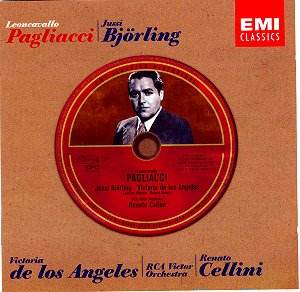Ruggero LEONCAVALLO
(1858-1919)
Pagliacci - Opera in Two
Acts
Canio, Jussi Björling (ten);
Nedda, Victoria de los Angeles, (sop);
Tonio, Leonard Warren (bar); Silvio,
Robert Merrill (bar); Beppe, Paul Franke
(ten)
 The Columbus Boychoir. The Robert Shaw
Chorale. RCA Victor Orchestra/Renato
Cellini
The Columbus Boychoir. The Robert Shaw
Chorale. RCA Victor Orchestra/Renato
Cellini
Recorded January 1953, Manhattan Center,
New York
 NAXOS HISTORICAL 8.110258 [68.54]
Bargain Price
NAXOS HISTORICAL 8.110258 [68.54]
Bargain Price
 EMI CLASSICS 7243 5 85650 2 3 [69.30]
Bargain Price
EMI CLASSICS 7243 5 85650 2 3 [69.30]
Bargain Price
Getting your retaliation
in first, once an adage of the rugby
field, has, in a manner of speaking,
transferred to the recording industry.
It has taken the emergence, from the
50-year copyright rule, (longer in the
USA), of recordings from the early LP
era to shake up the likes of EMI, in
particular, from a slothful and poor
marketing philosophy. The maintenance
of the Callas ‘La Scala’ recordings
at full price, on LP and then CD, when
over 40 years old was greatly resented
by the buying public, who often switched
their affections to rivals with a more
realistic and consumer oriented marketing
philosophy. So, aware that Naxos, with
its superb team of restorers, and other
labels, would be issuing re-masterings
from LP copies when the recordings emerged
from copyright, EMI has got in at the
same time and at roughly the same price
level. All things being equal, those
with access to the master tapes, EMI
in this case, should produce a better
CD product than a restoration from an
LP, no matter how silent the grooves.
However, it is not always that simple.
Certainly in the CD era collectors will
know of operas that have emerged in
the newer format with every indication
of gross sloppiness in re-mastering.
So what of this Pagliacci, where I have
been able to compare Mark Obert-Thorn’s
restoration for Naxos with an EMI re-mastering
based on access to master tapes?
I would like to preface
my comments about playback quality with
background to the recording and my impressions
of the performance. The performance
originates from an RCA Victor mono recording
of 1953, built round a cast of regular
Metropolitan Opera singers under a conductor
nearing the end of his stay on the staff
there. At this period RCA and HMV were
close collaborators, with cross-marketing
agreements and a willingness, not usual
at the time, to exchange contracted
artists. Victoria de los Angeles (b.1923)
was an HMV artist who had appeared in
the major opera houses of the world
since 1949. Her lightish voice was one
of great lyrical beauty with the capacity
for tonal contrasts. However, as I pointed
out in my review of the double disc
devoted to her in the first tranche
of EMI’s ‘The Very Best of’ series,
reviewed elsewhere
on this site, her use by the company
in various ‘verismo’ opera recordings
did not allow full appreciation of her
skills as can be better heard on the
recordings of Faust and La Bohème,
for example. So it is here when her
portrayal of Nedda often lacks commitment,
but not artistry, in a part she did
not attempt on stage until 1961 shortly
before she restricted her appearances
to the concert platform. Likewise the
heavy role of Canio was one that the
tenor Jussi Björling largely avoided
on stage, but on this recording his
beautiful voice, smooth legato and elegant
phrasing are heard to good effect and
as far as recording goes he has more
than enough heft for the dramatic outbursts.
Two great Americans baritones sing the
roles of Tonio and Silvio. Leonard Warren
(1911-1960) takes the part of the crippled
Tonio. His lean tone hits the A flats
of the ‘Prologue’ spot-on and without
strain and he characterises well throughout.
The tone of Robert Merrill (b.1917)
tone, as Silvio, is slightly more nasal
but rich and fully focused; the two
baritones could easily have reversed
roles. Cellini conducts with élan
rather than passion. He lets Leoncavallo’s
music convey the passion of the piece
and does not try to impose himself on
the music as several conductors of more
recent issues have done. Those wanting
a more modern stereo recording should
investigate the RCA with Domingo, Caballé,
the best Nedda on record, and Milnes,
or Karajan with the superb Bergonzi
as Canio (DG); each at mid price and
complete with libretto and translation.
There is also a very creditable modern
recording from Naxos under Rahbari at
bargain price. But those wanting this
enjoyable performance can choose between
these two versions; the question is
which?
In the Naxos issue
the voices are clear of the orchestra,
which has plenty of bass. The downside
is that the chorus and soloists do drown
out the orchestra (tr. 8), which has
plenty to say in this work. When it
comes to the ‘Intermezzo’ (tr. 18) the
orchestral sound comes over as slightly
veiled and the bass somewhat woolly.
The high frequencies are well caught,
but sound thinner than on the EMI (tr.
16) which also has more presence in
the bass where the cellos are richer
(at 0.40min). Listening straight through
each version, there was an edge to the
EMI sound that could become a little
tiring, but the general overall presence
was welcome. So the issue is clear?
Not quite. The Naxos booklet essay and
artist profiles, rather than EMI’s brief
mentions, are far superior. Likewise
the ‘track-related synopsis’ where the
EMI author attributes the concluding
‘La commedia è finita! (The play
is over) to Canio. Didn’t he or she
listen to the performance? The words,
like the ‘Prologue’, and as the composer
intended, are sung by Tonio, the correct
fact being given in the superior Naxos
track synopsis.
Whichever version you
choose you will enjoy a worthwhile and
well sung performance well realised
at a price unthinkable even a few years
ago.
Robert J Farr


